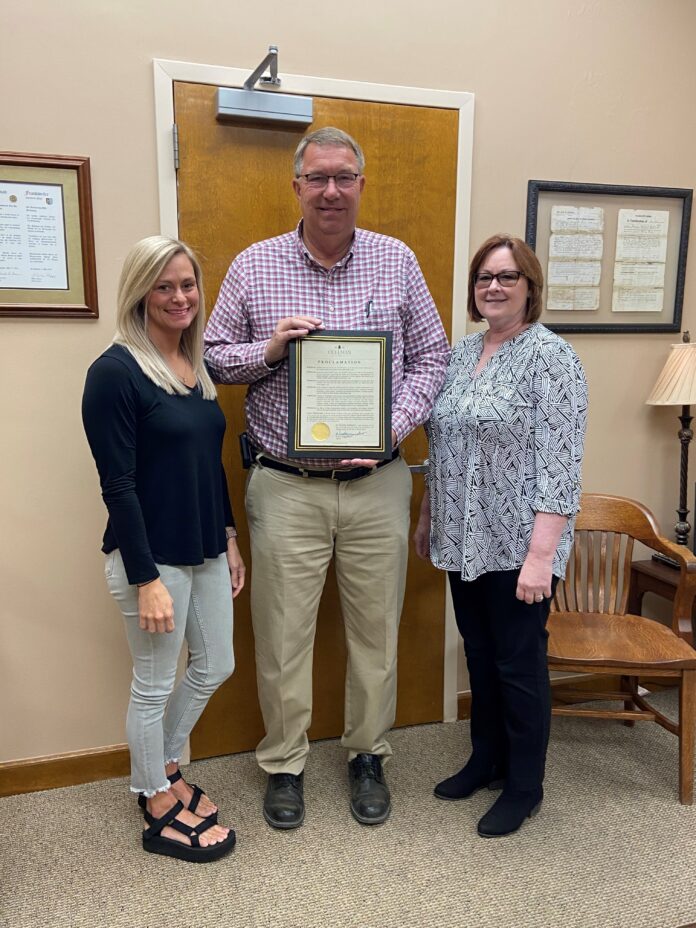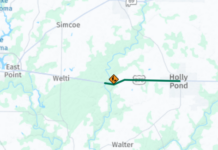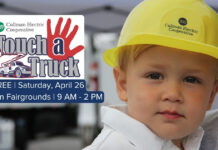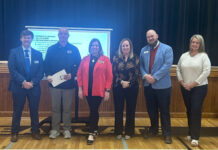
Cullman, Alabama – On Monday, March 28, 2022, Cullman Mayor Woody Jacobs presented a proclamation proclaiming April 2022 “Child Abuse Prevention and Awareness Month” to Brooks’ Place, The Child Advocacy Center of Cullman, Inc. On hand to receive the proclamation were Brooks’ Place Executive Director Gail Swafford and Family Advocate Haley Harris.
Mayor Jacobs previously proclaimed April to be “Child Abuse Prevention and Awareness Month” and recognized the work that Cullman Caring for Kids (CCK) and other organizations in Cullman do to bring awareness to and help victims and families deal with child abuse and neglect. Monday’s presentation was to recognize the vital role Brooks’ Place plays in responding to allegations of abuse.
“We have several agencies in Cullman that work together to help victims and families of child abuse, and during ‘Child Abuse Prevention and Awareness Month,’ I think it’s important to recognize them all,” said Mayor Jacobs. “Brooks’ Place, as a child advocacy center, is on the front lines of the battle against child abuse, and I am proud to recognize them and their work today.”
What is a child advocacy center (CAC)?
A child advocacy center is an organization that coordinates the investigation, treatment and prosecution of child abuse cases by utilizing teams of professionals involves in child protective and victim advocacy services, law enforcement and prosecution and physical and mental health. Child advocacy centers perform many vital functions including assisting child victims and their families through the forensic interviewing and providing evidenced-based therapeutic interventions, medical services and family advocacy.
What constitutes child abuse or child sexual abuse and what is its impact?
The Child Abuse Prevention and Treatment Act (CAPTA) defines child abuse and neglect as “any recent act or failure to act on the part of the parent or caretaker which results in death, serious physical or emotional harm, sexual abuse or exploitation … or an act or failure to act which presents an imminent risk of serious harm.”
According to reports issued by the Children’s Bureau (CB), an Office of the Administration for Children & Families (ACYF), administered by the U.S. Department of Health and Human Services (HHS), an estimated 618,000 children were found to be victims of child abuse or neglect nationwide last year and a reported 1,750 children died from abuse and neglect in the United States in the 2020 fiscal year. The HHS’s Child Maltreatment 2020 report found that almost 4 million allegations of child abuse or maltreatment were made involving over 7 million children in 2020. The report also found that the youngest children are the most vulnerable to maltreatment. Almost half of child fatalities due to maltreatment were in children younger than 1 year old. Also, for the 2020 fiscal year, almost 43,000 infants in 49 states were reported to have had prenatal substance exposure. These infants are born affected by substance abuse or withdrawal symptoms, and some have Fetal Alcohol Spectrum Disorder.
Childhood maltreatment is linked to later physical, psychological and behavioral consequences. The economic impact of abuse is staggering when taking into consideration childhood healthcare costs, adult medical costs, productivity losses, child welfare costs, criminal justice costs and special education costs.
However, for every interview conducted by a child advocacy center like Brooks’ Place, the average savings to taxpayers is $1,000!
Who are the abusers?
According to the Child Maltreatment 2020 report, the majority (83.2%) of perpetrators of child abuse or neglect are between the ages of 18 and 44, with most being between 25-34 years of age. More than half (52%) of perpetrators are female and the majority (77.2%) are parents to their victims. In fact, the data shows that 90.6 percent of child abuse victims are maltreated by one or both parents.
What services does Brooks’ Place provide?
Brooks’ Place provides a safe, private, child-friendly space to open up freely concerning their physical and/or sexual abuse. They also provide:
- Clinical Assessments
- Individual and Family Counseling
- Juvenile Sex Offender Management – J-SOAP
- Juvenile Risk Assessments
- Court School
- Medical Exams
- Multidisciplinary Team Coordination
- Professional Training Seminars
- Community Education
- Making a Difference
These services, provided at no cost, help reduce trauma for children who have been victims of abuse by reducing the number of interviews children must endure during an investigation, increase communication and collaboration among community agencies investigating and increase successful prosecutions of child abuse cases. The Brooks’ Place staff is caring and professionally trained, providing a well-coordinated and multidisciplinary response to allegations of abuse. Brooks’ Place also provides prevention training for children and their families as well as for counselors, educators and medical professionals.
Brooks’ Place provides HELP, HOPE and HEALING. When a child victim informs someone of sexual and/or physical abuse, Brooks’ Place begins to act. They first provide HELP by making sure that immediate needs (food, clothing, etc.) are met, that an interview is conducted, and that a forensic medical exam and physical are performed. Next, they provide HOPE through counseling. Finally, during the HEALING phase, is the trial and more counseling. Locally, Brooks’ Place interviews over 250 children annually.
What do I do if I suspect a child is being abused?
If you suspect a child is being harmed, reporting your suspicions may protect the child and get help for the family. For information about where and how to file a report in Cullman, contact local law enforcement (Cullman Police Department – 256-734-1434 | Cullman County Sheriff’s Office – 256-775-4700 | Hanceville Police Department – 256-352-9811) or the Cullman County Department of Human Resources (256-737-5300). You may also contact the National Child Abuse Hotline at 1-800-4ACHILD (800-422-4453).
What is ‘Child Abuse Prevention & Awareness Month”?
Each year, the month of April is recognized as National Child Abuse Prevention Month (NCAPM). By proclaiming April “National Child Abuse Prevention and Awareness Month” in Cullman, Mayor Jacobs is recognizing the importance of families and communities working together to strengthen families to prevent child abuse and neglect. NCAPM is authorized by the Child Abuse Prevention and Treatment Act (CAPTA), which provides funding to states to support prevention, assessment, investigation, prosecution and treatment of child maltreatment and grants to public agencies and nonprofit organizations for demonstration programs and projects. This month and throughout the year, the City of Cullman encourages all individuals and organizations to play a role in making Cullman an even better place for children and families. By ensuring that parents have the knowledge, skills, and resources they need to care for their children, we can help promote the social and emotional well-being of children and youth and prevent child maltreatment within families and communities. For more information about National Child Abuse Awareness Month visit.
More Information about Child Abuse:
Signs that a child may be being generally maltreated include, but are not limited to:
- Shows sudden changes in behavior or school performance.
- Does not receive help for physical or medical problems brought to the parents’ attention or lacks needed medical care (immunizations, dental care, glasses, etc.).
- Has difficulty concentrating that cannot be attributed to specific physical or psychological causes.
- Lacks adult supervision.
- Is always watchful, as though preparing for something bad to happen.
- Is overly compliant, passive or withdrawn.
- Seems reluctant to be around a particular person.
- Comes to school or other activities early, stays late and does not want to go home.
- Discloses maltreatment.
Physical Abuse: A non-accidental physical injury to a child caused by a parent or other caregiver which can include punching, beating, kicking, biting, shaking, throwing, stabbing, choking, hitting, burning, or otherwise causing physical harm. Some signs may include:
- Has unexplained injuries such as burns, bites, bruises, broken bones, or black eyes.
- Has fading bruises or other noticeable marks after an absence from school.
- Seems scared, anxious, depressed, withdrawn or aggressive.
- Seems frightened of parents and protests or cries when it’s time to go home.
- Shows changes in eating and sleeping habits.
- Abuses animals or pets.
- Shrinks at the approach of adults.
- Reports injury by a parent or other adult caregiver.
Neglect: The failure of a parent or other caregiver to provide for a child’s basic needs such as food or shelter, medical treatment, education needs or emotional needs. Some signs may include:
- Is frequently absent from school.
- Begs or steals food or money.
- Is consistently dirty and has severe body odor.
- Lacks needed medical care (immunizations, dental care, glasses, etc.)
- Lacks sufficient clothing for the weather.
- Abuses alcohol or other drugs.
- States there is no one at home to provide care.
Sexual Abuse: Includes activities by a parent or other caregiver such as fondling a child’s genitals, penetration, incest, rape, sodomy, indecent exposure and exploitation through prostitution or the production of pornographic materials. Some signs may include:
- Has difficulty walking or sitting.
- Experiences bleeding, bruising or swelling in their private parts.
- Suddenly refuses to go to school.
- Reports nighttime bedwetting.
- Experiences a sudden change in appetite.
- Demonstrates bizarre, sophisticated, or unusual sexual knowledge or behavior.
- Becomes pregnant or contracts a sexually transmitted disease, particularly if under age 14.
- Runs away.
- Attaches very quickly to strangers or new adults in their environment.
- Reports sexual abuse by a parent or another adult caregiver.
Emotional (Psychological) Abuse: A pattern of behavior that impairs a child’s emotional development or sense of self-worth that may include constant criticism, threats or rejection as well as withholding love, support, or guidance. Some signs may include:
- Shows extremes in behavior, such as being overly compliant or demanding, extremely passive or aggressive.
- Is either inappropriately adult (parenting other children, etc.) or inappropriately infantile (rocking, head-banging, etc.).
- Is delayed in physical or emotional development.
- Shows signs of depression or suicidal thoughts.
- Reports an inability to develop emotional bonds with others.
Abandonment: A child is considered abandoned when the parent’s identity of whereabouts are unknown, the child has been left alone in circumstances where the child suffers serious harm, the child has been deserved with no regard for his or her health or safety, or the parent has failed to maintain contact with the child or provide reasonable support for a specified period of time.
Parental Substance Use: Related circumstances include exposing a child to harm prenatally due to the mother’s use of legal or illegal drugs or other substances, manufacturing methamphetamine in the presence of a child, selling, distributing, or giving illegal drugs or alcohol to a child and using a controlled substance that impairs the caregiver’s ability to adequately care for the child.
Human Trafficking: Sex trafficking is recruiting, harboring, transporting, providing or obtaining someone for a commercial sex act such as prostitution, pornography or stripping. Labor trafficking is forced labor including drug dealing, begging, or working long hours for little pay.
Abusive or neglectful parents may exhibit signs such as:
- Showing little concern for, or appearing indifferent to, the child and refusing to consider offers of help for the child’s problems.
- Denying the existence of, or blaming the child for, the child’s problems in school or at home.
- Asking teachers or other caregivers to use harsh physical discipline if the child misbehaves.
- Seeing the child as entirely bad, worthless or burdensome.
- Demanding a level of physical or academic performance the child cannot achieve.
- Looking primarily to the child for care, attention and satisfaction of emotional needs.
- Constantly blaming, belittling or berating the child.
- Overtly rejecting the child.
- Seeming apathetic or depressed.
- Behaving irrationally or in a bizarre manner.
- Abusing alcohol or other drugs.
- Being unduly protective of the child or severely limiting the child’s contact with other children, especially of the opposite sex.
- Being secretive and isolated.
- Being jealous or controlling with family members.
If you suspect a child is being harmed, reporting your suspicions may protect the child and get help for the family. For information about where and how to file a report in Cullman, contact local law enforcement. You may also contact the National Child Abuse Hotline at 1-800-4ACHILD (800-422-4453).
Local Agencies & Departments
“Cullman is fortunate to have people and organizations who help children and families dealing with abuse and neglect,” said Mayor Jacobs. “We appreciate them all!”
For more information on these agencies, you can visit them online at:
To make a donation to Brooks’ Place, visit their website at: https://www.cullmancac.com/ call them at 256-739-2243, or mail your donation to P.O. Box 1252, Cullman, AL 35056-1252. 100% of their funding stays in Cullman and is provided by local donations.




















